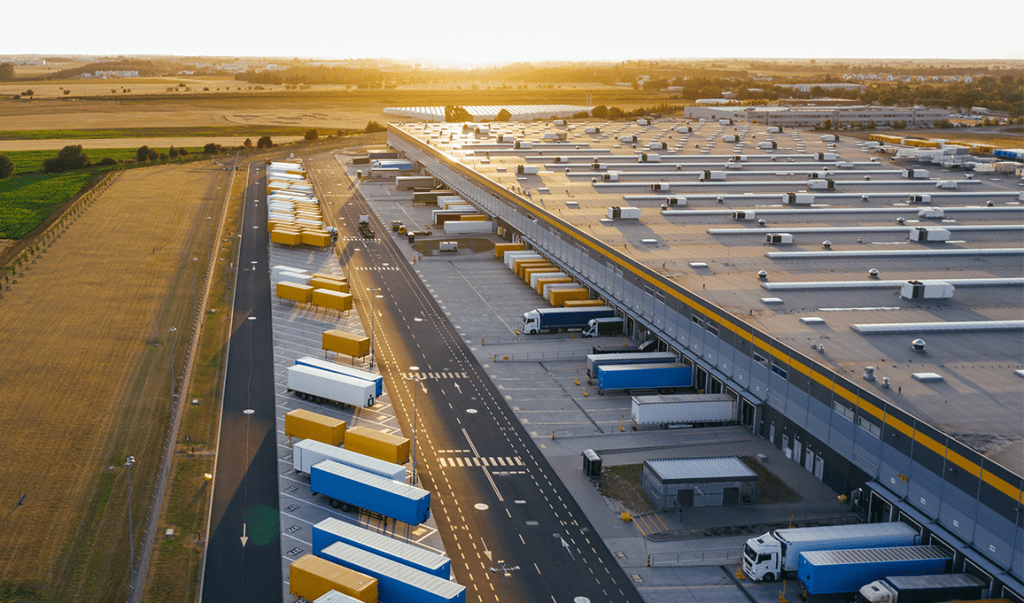Freight transportation is the backbone of the American economy, contributing $1.3 trillion to GDP in 2021 alone. Trucking leads the way in terms of transportation modes, making up $389 billion of this total — it literally drives the success of our businesses.
But there’s not a one-size-fits-all ground freight method. Knowing the differences between logistics can impact everything from your cost to how quickly your freight reaches its destination.
Today, we’ll look at one of the most important distinctions in ground freight transportation: less-than-truckload (LTL) vs full truckload (FTL) fulfillment.
LTL vs FTL: The Basic Modes of Ground Freight Logistics
Measured by weight, truckload shipments move nearly 73% of the country’s freight. From wholesale to eCommerce, thousands of businesses across industries rely on ground transportation to fulfill their orders.
The typical semi-trailer is about 53 feet long, 8.5 feet wide, and about 13.5 feet tall. With over 6,000 square feet of trailer space, businesses can either use the entire truck to transport large quantities or share space with others when delivering smaller orders. This focus on truckload is where the main freight classifications for ground transportation come from.

1. Less-Than-Truckload (LTL)
Less-than-truckload (LTL) is a shipment type where one business’s freight occupies just a segment of the trailer. These shipments contain products from multiple businesses, which lowers the price but also increases delivery time to accommodate multiple stops along the route.
LTL is often used in the following situations:
- Small shipments for eCommerce businesses
- Standard dimension freight that fits on pallets
- Dense, heavy freight that doesn’t take up much space
Splitting truckloads between multiple businesses means limitations on how much freight each vendor can ship via this mode. The weight range for LTL shipments generally ranges from 150–15,000 lbs. Logistics companies often limit the number of pallets you can include for LTL; the maximum is usually between 10 and 12 pallets.
2. Full Truckload (FTL)
Full Truckload (FTL) is a shipment type for businesses that need a truck’s entire space for their freight. Since full truckloads are dedicated to a single vendor, this mode offers one-stop shipping from origin to destination and faster delivery times.
FTL is generally used in the following situations:
- Large-volume shipments like manufacturing or wholesale
- Time-sensitive shipments that can’t afford multiple stops
- High-value freight that needs dedicated transport and minimal handling
The load weight range for FTL is usually over 15,000 lbs or orders with more than a dozen pallets. However, there’s a common misconception that FTL shipments must take up the full truck. While most 53’ semis can hold up to 26 pallets, there are instances when a merchant may choose to transport a smaller shipment via FTL for speed or limited handling.
According to The Cass Freight Index, full truckload shipping accounts for more than 50% of domestic shipments in the US, while less-than-truckload contributes around 25%.
3. Partial Truckload (PTL)
Some companies also offer partial truckload (PTL) fulfillment for freight that exceeds LTL weight restrictions but doesn’t require a full truck. The exact limits for PTL vary by logistics company, but this mode of transport is typically used in the following situations:
- Medium-sized shipments that don’t require dedicated transport
- High-value or fragile products that don’t need dedicated transport
- Low-density, low-wight freight that with larger dimensions
Whether or not a full truckload is used depends on the business size. Larger companies prefer dedicated truckloads, and smaller businesses opt for shared deliveries.
Below, we’ve outlined the 5 key differences between LTL and FTL to help you decide which freight shipping method is best for you.
5 Key Differences Between LTL and FTL
Don’t let the simplicity of the names fool you. There’s a lot more to know about these ground shipping methods. The decision between the two can affect everything from the safety of your products to customer experience to the profitability of your operations.
Here are 5 ways you can evaluate the differences between LTL and FTL:
- Dedicated space and service
- Touchpoints in transit
- Tracking and visibility
- Time in transit
- Price

1. Dedicated Space and Service
LTL shipments aggregate inventory from multiple shippers on a single truck. This means shippers share the cost of space on the truck and the drivers’ time.
LTL networks are very efficient, but you cannot control how the freight forwarder prioritizes your shipment among the many others you share a truck with. Alternatively, FTLs have more strict service level agreements regarding route efficiency, delivery time, and utilization of space.
News trends in warehouse distribution and carrier fleets also impact truckload fulfillment decisions. For instance, co-warehousing allows multiple businesses to share warehouse space and resources, which can make LTL shipping more efficient and cost-effective. At the same time, carriers are purchasing fewer Class 8 tractors, pointing to increased reliance on LTL, too.
2. Touchpoints in Transit
FTL shipments have a single origin and single destination, otherwise known as a dedicated lane. Your shipment stays on the same truck from the moment it leaves its departure destination to the moment it arrives at its destination. The limited handling helps reduce the risk of damage.
LTL shipments, on the other hand, stop at several hubs as they move through the network. Forwarders will move your product between trucks at several of these hubs. Every time your product moves is a new opportunity for damage, making FTL the ideal method for high-value or delicate products.
3. Tracking and Visibility
Order tracking is important to consumers and merchants in today’s digital-first economy. LTL shipments typically offer full order tracking and visibility while the shipment is in transit.
FTL shipments, on the other hand, have scheduled pickup and dropoff times, but they don’t usually support tracking while in transit. Since the driver(s) have a single shipment and are on a dedicated lane, their privacy is paramount. Any shipment location updates must be gathered through direct contact with the freight provider.
Regardless of the trucking mode, integrating carrier, warehousing, and order information in a central digital space for network visibility is an increasingly important practice.
4. Time in Transit
Time in Transit (TNT) tracks how long it takes for freight to reach its destination. A lower TNT means the product gets to its destination faster and emits less carbon to get there.
Because FTL shipments have a dedicated lane (a straight shot between their origin and destination), they also have a lower Time in Transit than LTL shipments. That said, it’s still possible to lower TNT for LTL shipments with the right carrier.
5. Shipping costs
The price for these truckload shipping options typically depends on the size and weight of the freight and how far it needs to travel. Because LTL shipments share space and labor with other shippers, they often offer more cost savings than FTL.
When transporting smaller freight shipments, it’s important to know if price or service is ultimately more important to your business. Merchants may choose to pay more to ship via FTL over LTL in the following instances:
- Their products are high-value or very fragile
- They’re shipping on a tight timeline
- They need a scheduled pickup or delivery time
Growing businesses or ones with variable demand can benefit by finding a fulfillment partner that provides 1-2 day shipping while offering the flexibility of both LTL and FTL shipping options. This allows them to optimize their cost and service levels as their needs change.
Other Considerations for Ground Freight Shipping
While the key factors outlined above are important, they aren’t the only basis for logistics decisions. Beyond the cost, time in transit, and number of touchpoints, businesses should also consider:
- Regulatory Compliance – For LTL, carriers must comply with weight restrictions and load balancing regulations, often facing stricter checks due to shared cargo. FTL shippers handle single loads and focus on maintaining compliance with hazardous material guidelines and weight limits, minimizing regulatory breaches.
- Insurance and Risk Management – LTL shipments, involving multiple touchpoints, carry higher risks of damage or loss, necessitating comprehensive insurance coverage. FTL shipments, with fewer stops and dedicated transport, present lower risk but often involve higher-value goods, requiring specific insurance policies to cover potential high-cost claims.
- Technological Integration – LTL carriers leverage advanced tracking systems and automated sorting technologies to manage multiple shipments efficiently. FTL providers use route optimization software and telematics to enhance delivery speed and safety.
- Customer Experience – LTL shipping offers cost-effective solutions but can result in longer delivery times and potential handling issues, impacting satisfaction. FTL provides faster, dedicated service with fewer handling touchpoints, enhancing reliability and customer confidence, especially for high-value or time-sensitive shipments.
Even seemingly simple decisions — like whether or not to use a full truckload to move your goods — have a major impact on your business. That’s why building your supply chain and fulfillment network with experienced partners is crucial.
Embrace Flexible Fulfillment with Ware2Go
Ground freight shipping is the foundation of American business. Whether you save costs by moving your freight shared shipping or require the entire truck for dedicated transport of high-value products, finding the right partner is key.
As a partner of UPS, Ware2Go has extensive experience with both ground freight shipping modes. Our nationwide network of over 25 warehouses allows you to grow your shipping strategy alongside your business. Plus our integrated tech gives you the data you need to decide between LTL vs FTL.
To learn more about shipping – from Ocean to final mile – check out our complete guide on freight logistics. For monthly supply chain insights and tips, sign up for our newsletter.




